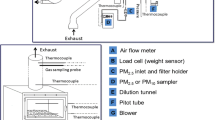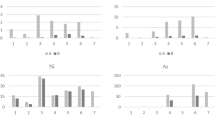Abstract
To control environmental pollution, a biodegradation technique involving a biomass is used to degrade the liquid wastes from certain industrial processes before disposal. (d, p) reactions were used to study the degradation process and the extent of removal of carbon and nitrogen. The PIXE-PIGME technique was used for the simultaneous study of the compositions of the biomass, the feed and the treated material. Measurements were obtained using protons of 2.5 MeV (for the PIXE-PIGME measurements) and deuterons of 2.0 MeV using currents of the order of 25nA. The X-ray and γ-ray data were recorded simultaneously. Absolute concentrations were obtained by comparison with measurements of calibration standards. Results show that 54–58% of the carbon and 45–50% of the nitrogen is removed from the wastes and that the biomass is concentrating Cl, Ti, Ni and Fe.
Similar content being viewed by others
References
M. K. DOSANJH, Report No. 2, Chemical Engineering Department, University of Birmingham, 1983; Ph. D. Thesis, 1985.
M. K. DOSANJH, D. A. J. WASE, Water. Res., 21 (1987) 205.
A. SAINT, N. A. DYSON, Proc. Intern. Conf. on Heavy Metals in the Environment, Heidelberg, 1983.
H. G. FAKHOURI, Ph. D. Thesis, Birmingham University, 1984.
Author information
Authors and Affiliations
Rights and permissions
About this article
Cite this article
Fakhouri, H.G., Dyson, N.A. (d, p) Reactions and the combination of PIXE-PIGME techniques for the analysis of biomass samples. Journal of Radioanalytical and Nuclear Chemistry, Articles 129, 163–170 (1989). https://doi.org/10.1007/BF02037579
Received:
Issue Date:
DOI: https://doi.org/10.1007/BF02037579




